Looking for an easy to follow RV setup checklist? Then keep on reading.
After almost 3 years of living in an RV full-time, our family has adjusted enough to commit fewer mistakes in our travels — be it staying in campsites or going on road trips.
We’ve moved past the beginner phase and we’re excited to give more tips to you guys.
Honestly, it took a while to adjust to the RV lifestyle, and recently we began RVing part-time as we found a home in Idaho. Yet we still love to get out and do some RV camping.
The important tip for RV beginners is mastering the basics. Basics are often overlooked but they are SO essential that you should need to prioritize them.
One of the basics that every RVer should master is setting up the RV campsite.
For this, we recommend that you make an RV camping checklist to guide you and make setting up an easier task. I’m going to share with you our top tips.
Read on to learn how to get a copy of our free RV camping checklist.
THIS ARTICLE MAY CONTAIN COMPENSATED LINKS. PLEASE READ OUR DISCLAIMER FOR MORE INFO. THIS POST WAS WRITTEN BY JILL GREISING-MURSCHEL, A FAMILY TRAVEL AND RV LIVING EXPERT.
Don’t have time to read a bunch of RV travel posts and reviews? Here are some of our top picks for RV living:
Our Favorite RV Resources:
- Ultimate RV Living eBook
- Harvest Hosts: (save 15% off your first year and stay overnight at one of the many farms, breweries, and wineries across the country)
- Romely Insurance – (sign up for full timer’s RV insurance and save big)
- Rent An RV With Outdoorsy – (the Airbnb of RVs)
- CampScanner – (Snag reservations at sold-out campgrounds!)
- RV Sheets – (Camping World Queen Short sheets made just for RV mattresses)
- Best Sewer Hose – (popular sewer hose for RVs)
- Best RV Vacuum – (small but mighty vacuum)
- Berkey Water Filters – (the travel Berkey is used by so many RV owners to get clean drinking water)
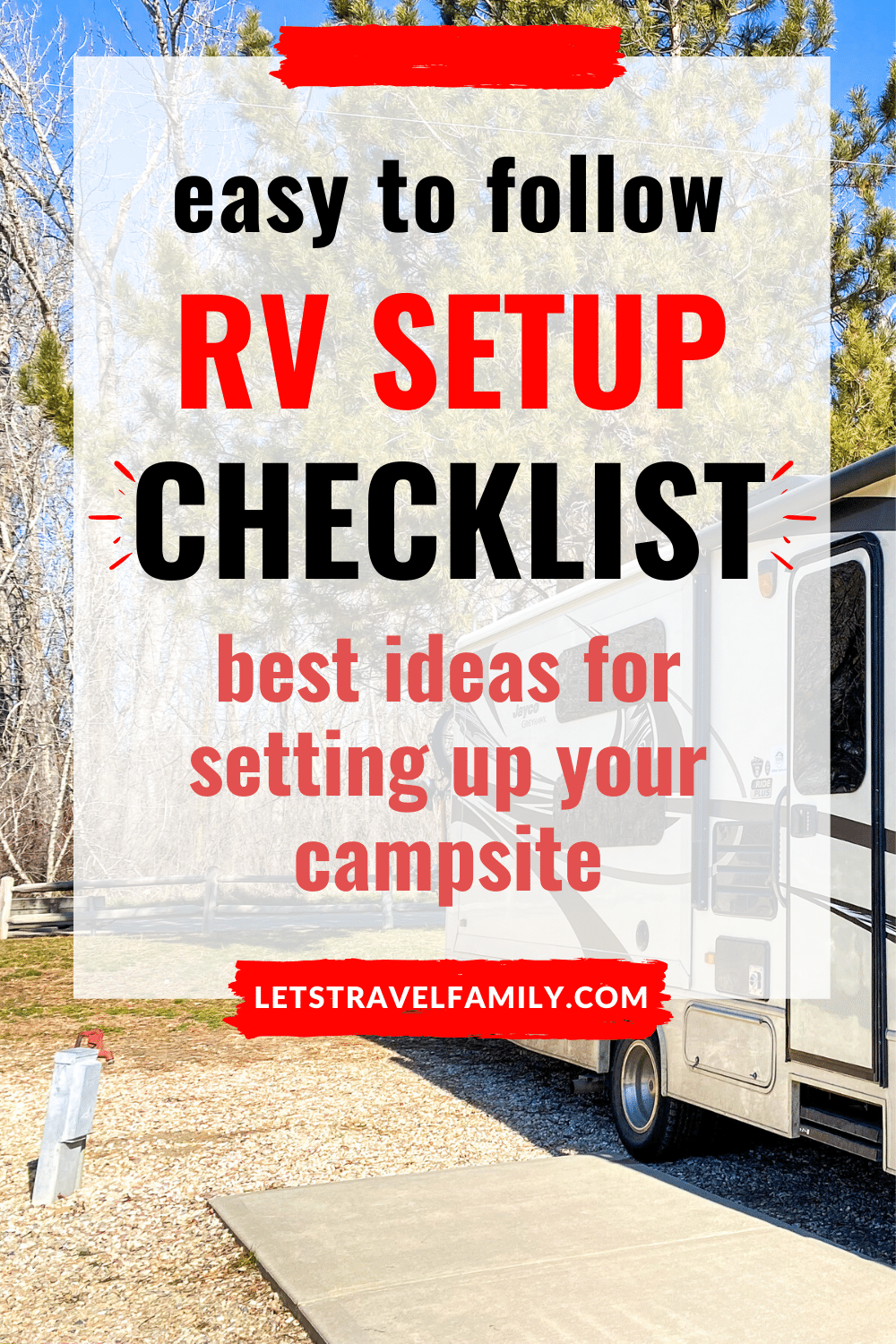
RV Setup Checklist FAQ
Setting up your new camper is an exciting adventure! You’ll want to start with the basics like leveling blocks, wheel chocks, and a water hose for hooking up to campground utilities. Consider investing in a surge protector to safeguard your water and electrical connections from unexpected power surges.
Regular maintenance is key to keeping your RV in tip-top shape for all your adventures. This includes routine checks on your tires, brakes, and seals to ensure everything is in working order. Don’t overlook the importance of keeping your RV’s interior and exterior items such as the trailer lights, checking tire pressure, and safety chains.
Preparing your RV for use is all about ensuring it’s safe, comfortable, and ready for the road. Start by thoroughly inspecting your RV for any signs of wear and tear, and address any issues before hitting the highway. Creating a RV teardown checklist is definitely the most effective way to plan your RV.
Packing your RV kitchen is all about convenience and efficiency. Essentials include pots and pans, utensils, plates, and cups, as well as cooking appliances like a stovetop or microwave. Don’t forget to stock up on non-perishable pantry items like spices, oils, and canned goods, and consider investing in space-saving storage solutions to make the most of your kitchen space on the road.
RV Setup Checklist: Tips on setting up your RV
Sometimes we feel like we already have everything we need and we have the routine down. Then we realize that we’re missing something once we’re already setting up, or we missed a step in the process.
Setting up your RV is much more technical can finding a great camper name for your RV. So don’t miss these simple steps.
1. Disconnect towed cars
Campgrounds can be full when you arrive. It is much easier to enter and drive around the campground without a tow vehicle connected to the back of your motorhome (if you have one). Besides, there’s no need to tow one once at the campground.
2. Survey your camp’s surroundings
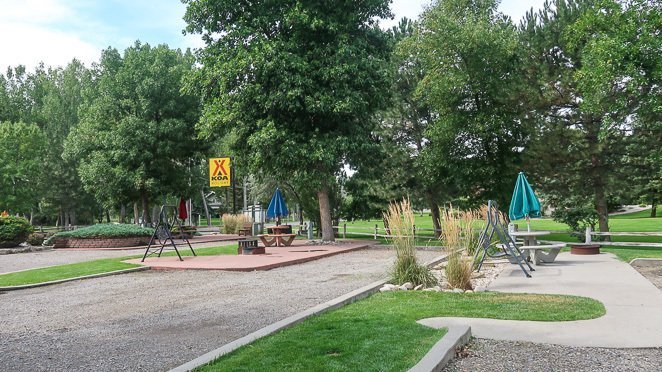
Check the tree branches and potholes in the campground to avoid damaging your vehicles. Consider the space for your awnings (if you have one and want to use it) and slideouts.
Also, remember where the electric, water, and sewer hook-ups are if you have them available to you at your campsite.
We really recommend that you arrive at your campsite during daylight so that it’s easier to do this.
3. Position the RV depending on hookup placement
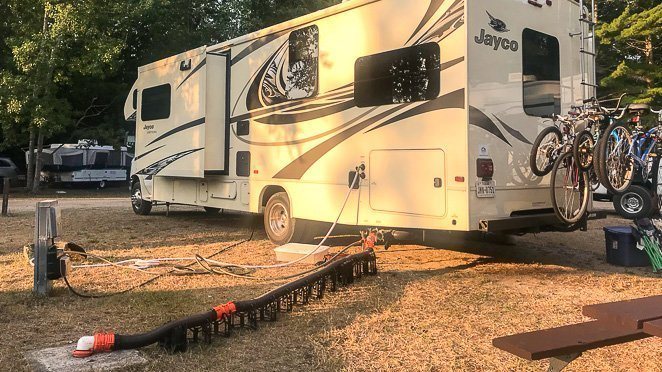
When you arrived to your assigned campsite, you’ll have to determine whether you’ll drive through or back up. Some campsites are pull-throughs and others you are required to back up.
To do this, check the placement of the hookups. Your RV setup will depend on the placement of the hookups – water, sewer, and electric.
4. Emergency brakes: ON
Before you step out of the Motorhome or your truck, remember to turn on the emergency brakes. Don’t forget this step. It’s not only essential for everyone’s safety at the campsite, if you’re driving a motorhome it may not even allow you to put the jacks down if you don’t have the emergency break on.
5. Leveling
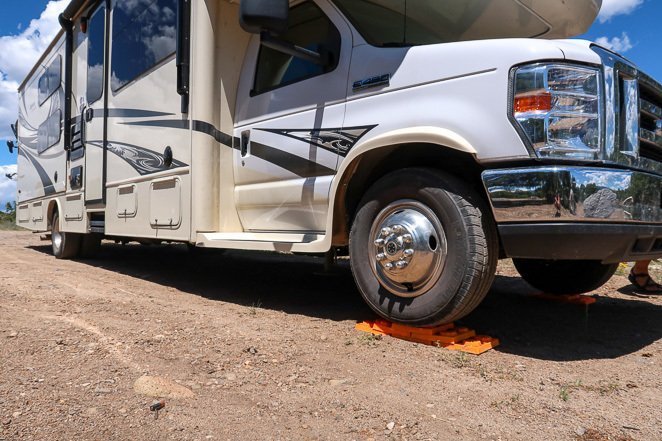
Not every campsite is flat and level. You will most likely have to make adjustments like leveling to make the RV stable.
There are different types of levels for RVs depending on if you have a travel trailer, fifth wheel, or motorhome. Be sure to at least have leveling blocks to place under your jacks or stabilizers. Then, if you have towable RV (a trailer that needs a tow vehicle) you’ll need chocks to hold the tires and RV in place.
If you want to know more about which leveling block is the best for your RV, check out our Best RV Leveling Blocks blog post!
6. Electric Hookups
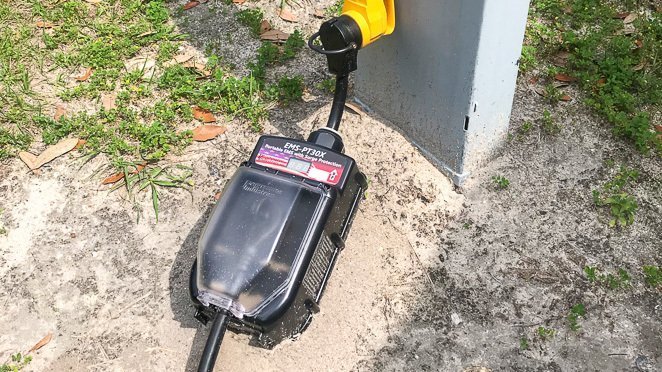
When you are finished leveling your RV, now you’ll need to take out your surge protector and hook it up before ‘plugging in’ your RV. Please don’t go without a surge protector, it will save your RV’s entire electrical system in so many cases. Click here to learn which surge protector to buy for your RV.
It’s one of the most important, in my opinion, RV necessities.
Grab Your FREE RV Setup Checklist.
Click below to receive the checklist that will make RV travel days so much easier.
7. Water Hookups
Hook up to the fresh water supply with the freshwater hose that you use ONLY for potable/fresh water. If you want to connect to a water filter or a water heater, this is the time to do so. Check for leaks right after.
Check out our list of RV essentials including the basics such as the fresh water hose and leveling blocks.
8. Sewer Hookups
Now, if you have a campsite with ‘full hook-ups’ that means you can connect your sewer hose at this point. I’d recommend hooking up the sewer hose and opening up your grey tank valve (shower and sink waste water), but keep your black tank closed. Only open the black tank valve when it’s at least half way full, so that gravity can do the job.
9. Let Out your awnings (or not)
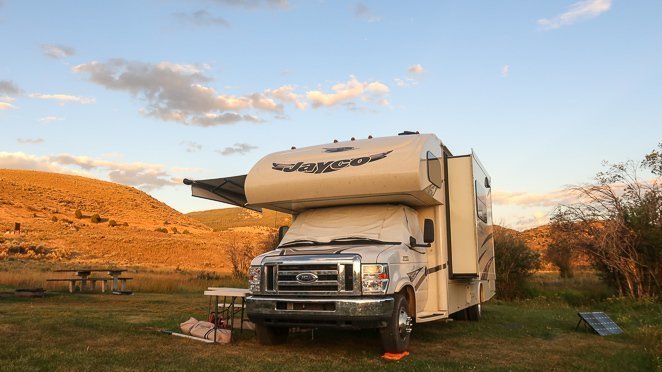
There are times when you don’t want to let out your awnings, or can’t. Bad weather with high winds or lack of space may prevent you from doing so.
In the case that you can let it out, do it after setting up and leveling. Remember to take the awnings back IN before you leave again. This is one of the most common RV safety mistakes that you have to avoid.
10. Mat, Tables, and Chairs
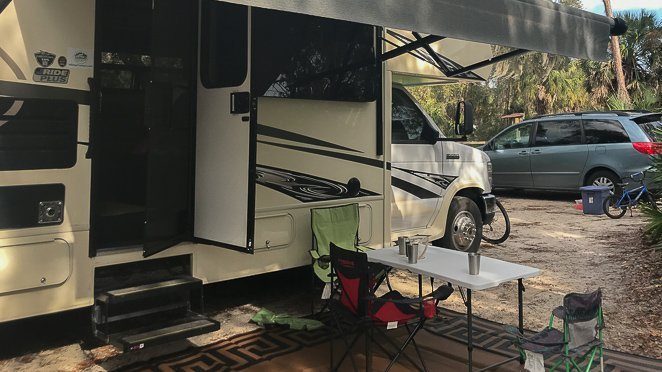
Once you’re done with the technicalities, you can set out the outside mat, tables, and chairs for a great camping experience!
Set up your favorite camping table and get ready to grill for dinner!
Take it slow
Be calm. Your mindset is very important in setting up your RV checklist, especially if it’s your first time.
We know that it can be stressful to have several campers watching your back during this process but it’s okay. You’re doing fine and if you ever need help, ask an experienced camper near you.
Remember that things go better with practice!
